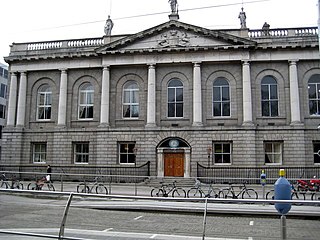Related Research Articles

Abraham Colles was Professor of Anatomy, Surgery and Physiology at the Royal College of Surgeons in Ireland (RCSI) and the President of RCSI in 1802 and 1830. A prestigious Colles Medal & Travelling Fellowship in Surgery is awarded competitively annually to an Irish surgical trainee embarking on higher specialist training abroad before returning to establish practice in Ireland.

The Royal College of Surgeons in Ireland (RCSI) is a medical professional and educational institution, which is also known as RCSI University of Medicine and Health Sciences, Ireland's first private university. It was established in 1784 as the national body for the surgical branch of medicine in Ireland, with a role in supervision of training, and as of 2021 provides a broad range of medical education in multiple countries.
The Royal College of Physicians of Ireland (RCPI), is an Irish professional body dedicated to improving the practice of general medicine and related medical specialities, chiefly through the accreditation of physicians by examination.

Dr Steevens' Hospital, one of Ireland's most distinguished eighteenth-century medical establishments, was located at Kilmainham in Dublin Ireland. It was founded under the terms of the will of Dr Richard Steevens, an eminent physician in Dublin. The seal of the hospital consisted of 'The Good Samaritan healing the wounds of the fallen traveller' with the motto beneath "Do Thou Likewise".

The School of Medicine at Trinity College in Dublin, Republic of Ireland, is the oldest medical school in Ireland. Founded in the early eighteenth century, it was originally situated at the site of the current Berkeley Library. As well as providing an undergraduate degree in medicine, the school provides undergraduate courses in physiotherapy, occupational therapy, radiation therapy, human nutrition & dietetics and human health & disease, over 20 taught postgraduate courses, and research degrees.

Mercer's Hospital was a hospital in Dublin, Ireland. It was converted into a clinical centre and medical library for the Royal College of Surgeons in Ireland in 1991.

Jervis Street Hospital was a hospital in Jervis Street in Dublin, Ireland. The site of the hospital became the Jervis Shopping Centre.

The Westmoreland Lock Hospital was a hospital for venereal disease originally located at Donnybrook and later moved to Lazar's Hill, Dublin, Ireland.

Sir Charles Alexander Cameron, CB was an Irish physician, chemist and writer prominent in the adoption of medical hygiene. For over fifty years he had charge of the Public Health Department of Dublin Corporation. He was elected President of the Royal College of Surgeons in Ireland (RCSI) in 1885.

James Little was an Irish medical practitioner. After spending an early part of his career as a ship's surgeon, surviving a shipwreck, he became chief physician at the Adelaide Hospital in Dublin and Regius Professor of Physic at Trinity College Dublin.
The Apothecaries' Hall of Ireland is one of only two extant successors of a medieval Dublin guild. Medieval apothecaries in Dublin were first organized as members of 1446 Guild of Barbers, Apothecaries and Periwigmakers, with St Mary Magdelene as the patron saint. In 1747, Apothecaries formed their own guild, with St Luke as the patron. In 1791, the Company of Apothecaries’ Hall was formed for the purpose of building a Hall and regulating practitioners. Although the Company ceased licensing doctors in 1971, it continues to exist as a charitable organisation. The Company of Apothecaries’ Hall is now hosted by and shares premises with the Royal College of Physicians of Ireland on Kildare Street, Dublin.

Samuel Croker-King was an Irish surgeon who was associated with Doctor Steeven's Hospital in Dublin for sixty years. He was the first president of the Royal College of Surgeons in Ireland (RCSI), from 1784 to 1785. He is thought to have saved the life of the child who became the Duke of Wellington. He invented his own trepanning device.

John Whiteway was a Dublin surgeon who was the second President of the Royal College of Surgeons in Ireland (RCSI) in 1786.

Philip Woodroffe was the resident surgeon at Dr Steevens' Hospital in Dublin for over 30 years. Several eminent surgeons were apprenticed to him. He was the president of the Royal College of Surgeons in Ireland (RCSI) in 1788.

Ralph Smith O'bré was an Irish physician who was the president of the Royal College of Surgeons in Ireland (RCSI) in 1790. He served as an army surgeon before setting up practice in Dublin where he became wealthy. He invented a popular double tracheostomy tube.

Solomon Richards was an Irish surgeon who served four terms as president of the Royal College of Surgeons in Ireland (RCSI) in 1794, 1803, 1808, and 1818. He achieved fame by performing a tracheotomy in public for which act he featured in a satirical poem in The Metropolis. He was praised for his philanthropy and noted for his puns and bon mots. He was said to be the "fattest surgeon in the United Kingdom".

Gustavus Hume was the president of the Royal College of Surgeons in Ireland (RCSI) in the first part of 1795. He specialised in the diseases of children. He was one of the surgeons who examined the body of the journalist William Jackson after he died from poisoning in a Dublin court in 1795 while awaiting sentencing for high treason.

Patrick Cusack Roney or Rooney was an Irish physician who was president of the Royal College of Surgeons in Ireland (RCSI) in 1814 and 1828.

Charles Hawkes Todd was a medical doctor and the president of the Royal College of Surgeons in Ireland (RCSI) in 1821.

Thomas Edward Beatty was an Irish physician, and the president of the Royal College of Surgeons in Ireland (RCSI) in 1850.
References
- ↑ Cameron, Sir Charles A. (1886) History of the Royal College of Surgeons in Ireland, and of the Irish Schools of Medicine &c Dublin: Fannin & Co. p. 40.
- ↑ The medical review. Trove. Retrieved 10 May 2018.
- ↑ The triumphant return. Stanford Libraries. Retrieved 10 May 2018.
- ↑ De regis convalescentia. Stanford Libraries. Retrieved 10 May 2018.